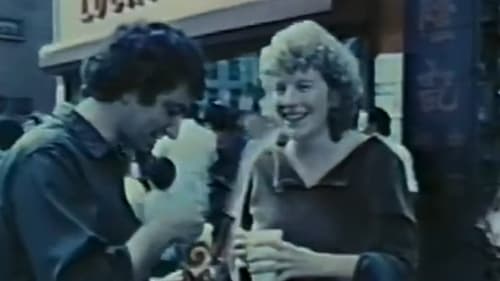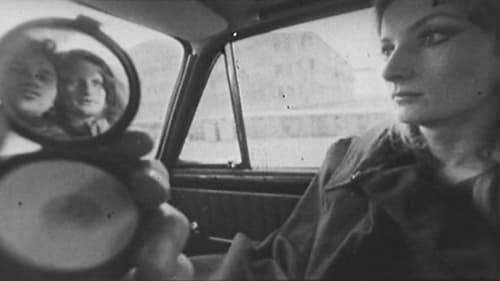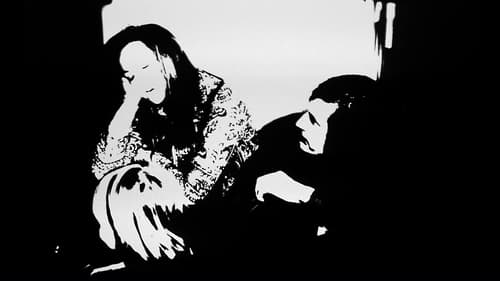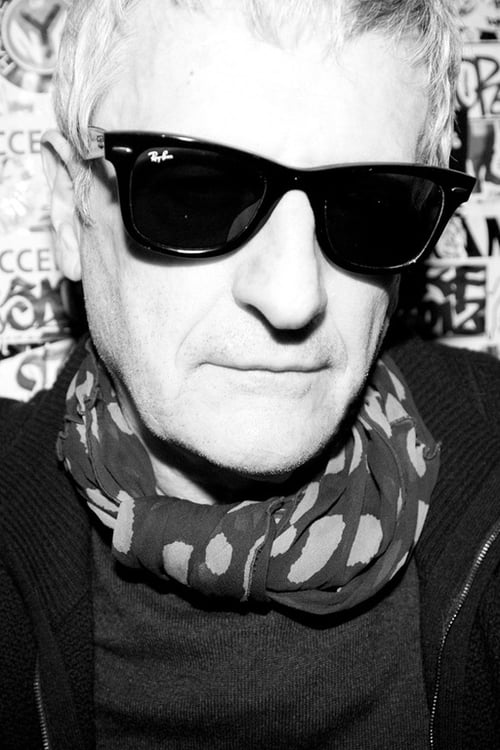
Director
For the past 50 years, Michel Auder has been recording his personal life, creating films and videos that document his own experience and social milieu. His new work, Fictional Art Film, is a composite portrait of Auder’s New York art world during the 70’s and 80’s. The filmmaker recorded his friends, the artists and writers he hung around and admired. These now-famous subjects (which include Alice Neel, Andy Warhol, John Ashbery, David Hammons, Hannah Wilke, Willem de Koonig, and Bill T. Jones, among many others) are shown here both as people and performers, with Auder’s footage often blurring the line between life and art.

Director
For the past 50 years, Michel Auder has been recording his personal life, creating films and videos that document his own experience and social milieu. His new work, Fictional Art Film, is a composite portrait of Auder’s New York art world during the 70’s and 80’s. The filmmaker recorded his friends, the artists and writers he hung around and admired. These now-famous subjects (which include Alice Neel, Andy Warhol, John Ashbery, David Hammons, Hannah Wilke, Willem de Koonig, and Bill T. Jones, among many others) are shown here both as people and performers, with Auder’s footage often blurring the line between life and art.

Director

Director
The Course of Empire is inspired by the eponymous series of paintings created by Thomas Cole from 1833 to 1836. A 'text film,' constructed from iPhone images of writings by James Baldwin, Donna J. Haraway, and Arthur Rimbaud, it also features excerpts from Alexander von Humboldt’s slave-trade opus Personal Narrative of Travels to the Equinoctial Regions of the New Continent during the Years 1799–1804.

Director
Gulf War TV War was made in one of Auder's usual domestic modes: filming his TV, in which he documents American television news during the run-up to the first Gulf War, a mixture of crass propaganda and feeble journalism, image and text. Montages of antiwar demonstrators marching across Manhattan and gray-faced politicians at dark desks extolling invasion compete with commercials and text scrolling the pixilated screen.

Director
Shot on his phone in 2016, Michel Auder’s latest work delves into stasis and acceleration at the same time: a compressed pack of digital memories indiscriminately flickering across the screen in rapid succession, separated by glimpses of nothingness.

Director
1967 (made in 2015) presents newly found and digitized silent 16mm films from the 1960s in the form of a four-part composition portraying a cast of artists, writers, musicians and actors who made up the bohemian underground of that time. The film recasts the essence of a scene whose participants have since been idealized as celebrities or else forgotten.

Director
HD video by Michel Auder.

Director
Michel Auder dedicated himself to capturing the views from his apartment over the course of a year. This three-channel video installation from 2014 is based on that footage.

Director
Narcolepsy includes footage shot with a small hand-held digital video camera, mobile phones and underwater devices. The videos appear on one monitor at a time, as the rest remain blank. A transparent rabbit in bed is superimposed on a dog in the snow; hands being washed under a faucet are juxtaposed with an outdoor flood; little girls play with dolls and mothers tend real babies; a spider web holds a captive fly.

Director
Phone video by Michel Auder.

Director
Hi8 video by Michel Auder, recorded 1990, edited 2009.

Director
16mm film transferred to SD video, recorded 1970, edited 2009. An excerpt from Michel Auder's film Cleopatra (1970).

Director
Reel-to-reel video by Michel Auder, recorded 1971, edited 2009. Features Auder's former wife Viva.

Director
Video recorded in NYC by Michel Auder in 1983, edited in 2009.

Cinematography
The Feature does not reconcile fact and fiction; instead, it blurs the definitions seemingly represented by the film’s two clearly demarcated registers: that of the archival footage and that of the new, theatrical material. In his guise as “Michel Auder,” living a fulsome and extravagant life, replete with beautiful women and a rock-cut pool overlooking Los Angeles, the art world is revealed as a sham, and his character exhibits a repulsive narcissism. And yet, when caught in quiet moments, something poignant emerges—a glimmer of truth that rebels against the entire endeavour. Or maybe, that’s what makes The Feature.

Writer
The Feature does not reconcile fact and fiction; instead, it blurs the definitions seemingly represented by the film’s two clearly demarcated registers: that of the archival footage and that of the new, theatrical material. In his guise as “Michel Auder,” living a fulsome and extravagant life, replete with beautiful women and a rock-cut pool overlooking Los Angeles, the art world is revealed as a sham, and his character exhibits a repulsive narcissism. And yet, when caught in quiet moments, something poignant emerges—a glimmer of truth that rebels against the entire endeavour. Or maybe, that’s what makes The Feature.

The Feature does not reconcile fact and fiction; instead, it blurs the definitions seemingly represented by the film’s two clearly demarcated registers: that of the archival footage and that of the new, theatrical material. In his guise as “Michel Auder,” living a fulsome and extravagant life, replete with beautiful women and a rock-cut pool overlooking Los Angeles, the art world is revealed as a sham, and his character exhibits a repulsive narcissism. And yet, when caught in quiet moments, something poignant emerges—a glimmer of truth that rebels against the entire endeavour. Or maybe, that’s what makes The Feature.

Director
The Feature does not reconcile fact and fiction; instead, it blurs the definitions seemingly represented by the film’s two clearly demarcated registers: that of the archival footage and that of the new, theatrical material. In his guise as “Michel Auder,” living a fulsome and extravagant life, replete with beautiful women and a rock-cut pool overlooking Los Angeles, the art world is revealed as a sham, and his character exhibits a repulsive narcissism. And yet, when caught in quiet moments, something poignant emerges—a glimmer of truth that rebels against the entire endeavour. Or maybe, that’s what makes The Feature.

Director
Hi8 video by Michel Auder recorded in 1989, edited in 2008.

Director
Video interviews of passerby at the World Trade Center by artist Marcia Resnick. Recorded 1976, edited 2007.

Video by Michel Auder.

Director
Video by Michel Auder.

Director
Video by Michel Auder.

Video by Michel Auder.

Self
Filmmaker Jonas Mekas films 160 underground film people over four decades.

Director
Voyage's structure is simple. Coastal landscape footage and spectacular sunsets are combined with phone conversations recorded from a scanner that picks up cordless phone frequencies.

Director
The thrill of cocaine becomes a metaphor for the consumption of images in this short montage. The title and lyrics come from Auder´s friend and 2001 Prix Goncourt winner Jean-Jacques Shuhl. The piece is composed entirely of still photographs from a variety of books and magazines that simultaneously reveal and feed an addiction to spectacle. With a source that is once removed, Auder's scopophilia is symptomatic of society at large. The song is performed by legendary chanteuse Ingrid Caven. Suffused with a bittersweet melancholy, Canven's seasoned voice compliments Auder's selection of images which dwell on the themes of death, destruction and desire.
The melody is classic cabaret performed by a piano/violin duo who dramatically heighten the works already dark eroticism.

Director
Video recorded in 1986, edited 1993. ”You know you're addicted to heroin when you begin proclaiming every bag to be your last.” Auder says this from experience. Throughout the early and mid 1980s he was an addict. In this candid piece of disclosure he demonstrates a method of smoking heroin referred to as Chasing the Dragon. Drumming his fingers on the table-top while waiting for the high to take effect, heroin use is depicted as a boredom far from bliss. The work ends with Auder in a druginduced stupor, delivering a rambling proclamation about kicking the habit, ”good-bye dope, good bye monkey.”

Video recorded in 1986, edited 1993. ”You know you're addicted to heroin when you begin proclaiming every bag to be your last.” Auder says this from experience. Throughout the early and mid 1980s he was an addict. In this candid piece of disclosure he demonstrates a method of smoking heroin referred to as Chasing the Dragon. Drumming his fingers on the table-top while waiting for the high to take effect, heroin use is depicted as a boredom far from bliss. The work ends with Auder in a druginduced stupor, delivering a rambling proclamation about kicking the habit, ”good-bye dope, good bye monkey.”

Director
A portrait of Rome that would have made Plutarch proud, Roman Variations was made during a residency at a studio provided by the gallerist Barbara Gladstone.

Director
Auder's reminiscences from 1986 - 87.

Director
From its fiery outset, Brooding Angles is decidedly gothic and the mood anxious. It is a dark rumination on the specter of authority, resistance and paranoia marking the close of Reagan's second term in office. Born in 1945, Auder came of age during the 1960s, a decade as tumultuous in France as it was in the United States. The decade culminated in the student/worker strikes of May 1968 that shut down the city of Paris. Auder's value system was in many respects shaped by this anti-authoritarian milieu. Its remnants are to be found in his preponderance with issues violence and conflict as they serve to question moral progress. The soundtrack's ominous melody is recycled from footage of cellist David Soyer that can be seen in A Portrait of Alice Neel.

Director
Critic Gary Indiana wrote this satire and plays Dom, a rich, naive and young homosexual who moves into his sister's apartment. He immediately becomes involved with the lives of his quirky new neighbors. Rippley (Taylor Meade) is the chatty but depressed author and talk show host. Dominatrix Mavis (Cookie Mueller) drops by to visit or ask for child sitting favors when free from the demands of her kinky clients. Jackie Curtis plays Buddie, the handsome hunk who picks up Dom in a local bar, and Geoffrey Carey is the Angel of Death who carefully watches over all activity. (IMDb)

Director
In Michel Auder's short video Talking Head, a young girl (presumably his daughter) is occupied with a plastic toy-package of some sort. She talks incessantly about 'a nothing-nothing'; 'a thing that never came back again…. everyone was mad about it and sad about it…but nothing ever happened'. Michel Auder, hiding behind a Yucca (or some such exotic plant), films the girl telling this story. She develops her 'story' circumventing and encompassing this nothing-thing, and she does it in a hypnotizing and repetitive way, like a mantra, using all the permutations possible with a minimum amount of words or facts.

Director
Michel reads a book about love, with pictures of naked ladies flashing by and a song by Laurie Anderson playing in the background.

Editor
Michel Auder’s Jesus – in which underground NY artists and Warhol superstars openly discuss their beliefs. Jesus – which premiered as a screening at The Kitchen in 1980 – mixes documentary elements such as footage of evangelical TV programs, books, cartoons, paintings, and other Jesus related imagery – with performances including Taylor Mead as a priest in the West Village and Florence Lambert playing a crucified Jesus. Also, intercut throughout are surprisingly candid interviews with Auder’s friends, family, and people he approaches on New York City streets about their faith and relationship to the world’s most famous person. Among those interviewed are Diego Cortez, Jackie Curtis, Gerard Malanga, Alice Neel (Andrew Neel’s grandmother), Larry Rivers, and Viva.

Producer
Michel Auder’s Jesus – in which underground NY artists and Warhol superstars openly discuss their beliefs. Jesus – which premiered as a screening at The Kitchen in 1980 – mixes documentary elements such as footage of evangelical TV programs, books, cartoons, paintings, and other Jesus related imagery – with performances including Taylor Mead as a priest in the West Village and Florence Lambert playing a crucified Jesus. Also, intercut throughout are surprisingly candid interviews with Auder’s friends, family, and people he approaches on New York City streets about their faith and relationship to the world’s most famous person. Among those interviewed are Diego Cortez, Jackie Curtis, Gerard Malanga, Alice Neel (Andrew Neel’s grandmother), Larry Rivers, and Viva.

Writer
Michel Auder’s Jesus – in which underground NY artists and Warhol superstars openly discuss their beliefs. Jesus – which premiered as a screening at The Kitchen in 1980 – mixes documentary elements such as footage of evangelical TV programs, books, cartoons, paintings, and other Jesus related imagery – with performances including Taylor Mead as a priest in the West Village and Florence Lambert playing a crucified Jesus. Also, intercut throughout are surprisingly candid interviews with Auder’s friends, family, and people he approaches on New York City streets about their faith and relationship to the world’s most famous person. Among those interviewed are Diego Cortez, Jackie Curtis, Gerard Malanga, Alice Neel (Andrew Neel’s grandmother), Larry Rivers, and Viva.

Director
Michel Auder’s Jesus – in which underground NY artists and Warhol superstars openly discuss their beliefs. Jesus – which premiered as a screening at The Kitchen in 1980 – mixes documentary elements such as footage of evangelical TV programs, books, cartoons, paintings, and other Jesus related imagery – with performances including Taylor Mead as a priest in the West Village and Florence Lambert playing a crucified Jesus. Also, intercut throughout are surprisingly candid interviews with Auder’s friends, family, and people he approaches on New York City streets about their faith and relationship to the world’s most famous person. Among those interviewed are Diego Cortez, Jackie Curtis, Gerard Malanga, Alice Neel (Andrew Neel’s grandmother), Larry Rivers, and Viva.

Director
Super 8 film transferred to SD video.

Director
Through the use of original and appropriated video footage, Auder translates a religious sermon into an expression of love for this strikingly beautiful woman. This lovers tale opens with a photograph of Denise that is alternately caressed and crushed in the palm of her lover's hand; a gesture oscillating between affection and an obsessive and irrational desire for possession. Auder builds on the increasing grandeur of the sermon's metaphors, extending them into the realm of destruction. The mood undergoes a violent shift as what was once fruit and flowers abruptly gives way to catastrophe. Featuring the music of Philip Glass, whose acquaintance Auder made in the early 1970s while producing work for The Kitchen.

Director
In 1969 Michel Auder began a series of video diaries that chronicled the art scene in downtown New York. In Chelsea Girls with Andy Warhol, Auder captures revealing moments in Warhol's public and private life: the opening of the 1970 Whitney Museum retrospective, a party held at John Lennon and Yoko Ono's home, a heated telephone conversation between Warhol, Viva and Brigid Berlin, and an illuminating interview conducted with Larry Rivers, the grandfather of Pop Art, following the publication of The Philosophy of Andy Warhol in 1975. The issue of money is a consistent topic of conversation with Viva, who after departing the Factory in 1969 sent Warhol a series of threatening letters demanding money.

Director
The Chronicles capture the natural and cultural beauty of Morocco from its ancient walled villages to its nomadic caravans. Music comes from everywhere. Edited almost thirty years apart, the two Chronicles together are a study in Auder's approach to his memories. The footage is all from the same trip that was a family vacation. Considering Chronicles/Morocco, 1971 a construct of emotional convenience unfaithful to memory, Auder decided to supplement the first version with a fuller account. The two works feature almost entirely different footage. There are, however, sections where one can see where Auder has omitted Viva. The star of the 1971 version is a young Moroccan Adonis who appoints himself tour-guide for a group of Europeans including Michel. The camera follows his charming antics as he flaunts his nubile body and rather blunt but effective skills as a hunter.

The Chronicles capture the natural and cultural beauty of Morocco from its ancient walled villages to its nomadic caravans. Music comes from everywhere. Edited almost thirty years apart, the two Chronicles together are a study in Auder's approach to his memories. The footage is all from the same trip that was a family vacation. Considering Chronicles/Morocco, 1971 a construct of emotional convenience unfaithful to memory, Auder decided to supplement the first version with a fuller account. The two works feature almost entirely different footage. There are, however, sections where one can see where Auder has omitted Viva. The star of the 1971 version is a young Moroccan Adonis who appoints himself tour-guide for a group of Europeans including Michel. The camera follows his charming antics as he flaunts his nubile body and rather blunt but effective skills as a hunter.

Director
In 1970 Valerie Solanas was released from a mental institution, two
years after shooting Andy Warhol. Still unstable, she moved into the
Chelsea Hotel where she penned a death threat to Michel Auder and his
wife Viva. Using a soundtrack by Wagner, Auder surveys the handwritten
evidence of Solanas's threat, before reciting its threatening prose
melodramatically.

Self
Documentary portrait of Henri Langlois, co-founder of the Cinémathèque Française.

Director
Cleopatra situates itself in the same relationship to Hollywood as the Warhol/Morrisey films of the period. It corresponds to Joseph Mankiewicz's 1963 Cleopatra, starring Elizabeth Taylor and Richard Burton which Auder's cast watched and used as the starting point for scene by scene improvisation Auder drew his cast from Warhol's ensemble – including not only Viva and Louis Waldon, but also Taylor Mead, Ondine, Andrea Feldman, Gerard Melanga and others.

"The question is, it is either going to be a stoned age or a new Stone Age" - Louis Brigante

“FUN AND GAMES (FOR EVERYONE): a pitch black and milky white film shot during one of Olivier Mosset's exhibition openings. A psychedelic game of improvisation joins the Zanzibar group with Salvador Dalí, Barbet Schroeder and Jean Mascolo... the solarized image reminiscent of thick strokes of a paintbrush.” - Philippe Azoury

Director
Warhol Superstars Viva and Louis Waldon are the main subjects of Auder’s first film with synched sound, Keeping Busy (1969), which was billed as “a film novel about what they did to keep busy.”

The film begins with shots in Venice, passers-by seized from a hotel room, with Tina Aumont. It continues in Morocco during the filming of Bed of the Virgin, in a hotel room, people chat, play the guitar, smoke.

One of the very few films made by Etienne O'Leary, all of which emerged from the French underground circa 1968 and can be very loosely designated 'diary films.' Like the contemporaneous films by O'Leary's more famous friend Pierre Clementi, they trippily document the drug-drenched hedonism of that era's dandies. O'Leary worked with an intoxicating style that foregrounded rapid and even subliminal cutting, dense layering of superimposed images and a spontaneous notebook type shooting style. Yet even if much of O'Leary's material was initially 'diaristic,' depicting the friends, lovers, and places that he encountered in his private life, the metamorphoses it underwent during editing transformed it into a series of ambiguously fictionalized, sometimes darkly sexual fantasias. - Experimental Film Club

Homeo is a mental construction made from visual reality, just as music is made from auditive reality. I put in this film no personal intentions. All my intentions are personal. I’ve made this film thinking of what the audience would have liked to see, not something specific that I wanted to say: what the film depicts is above all reality, not fiction. Homeo is, for me, the search for an autonomous cinematographic language, which doesn't owe anything to traditional narrative, or maybe everything. Cinema is, above all, part of a way of life which will become more and more self-assured in the years and century to come. We are part of this change, and that’s why I tried in Homeo to establish a series of perpetual changes, in constant evolution or regress, which tries, above all, to focus on things.




